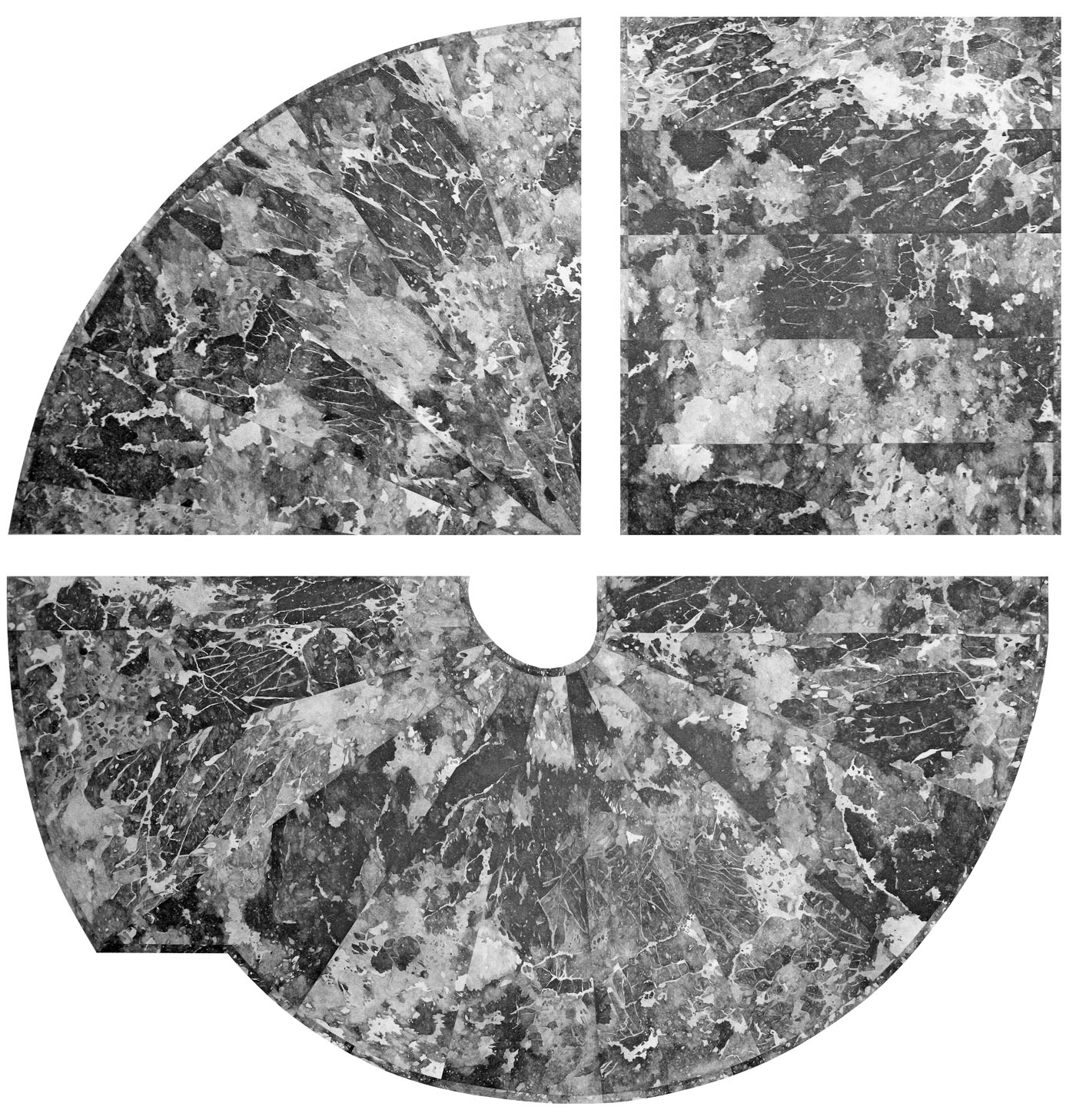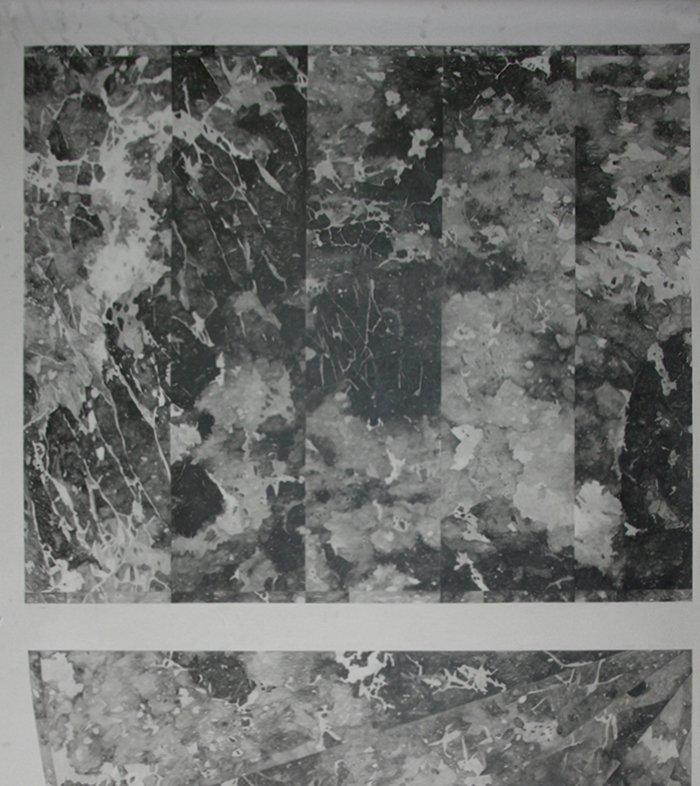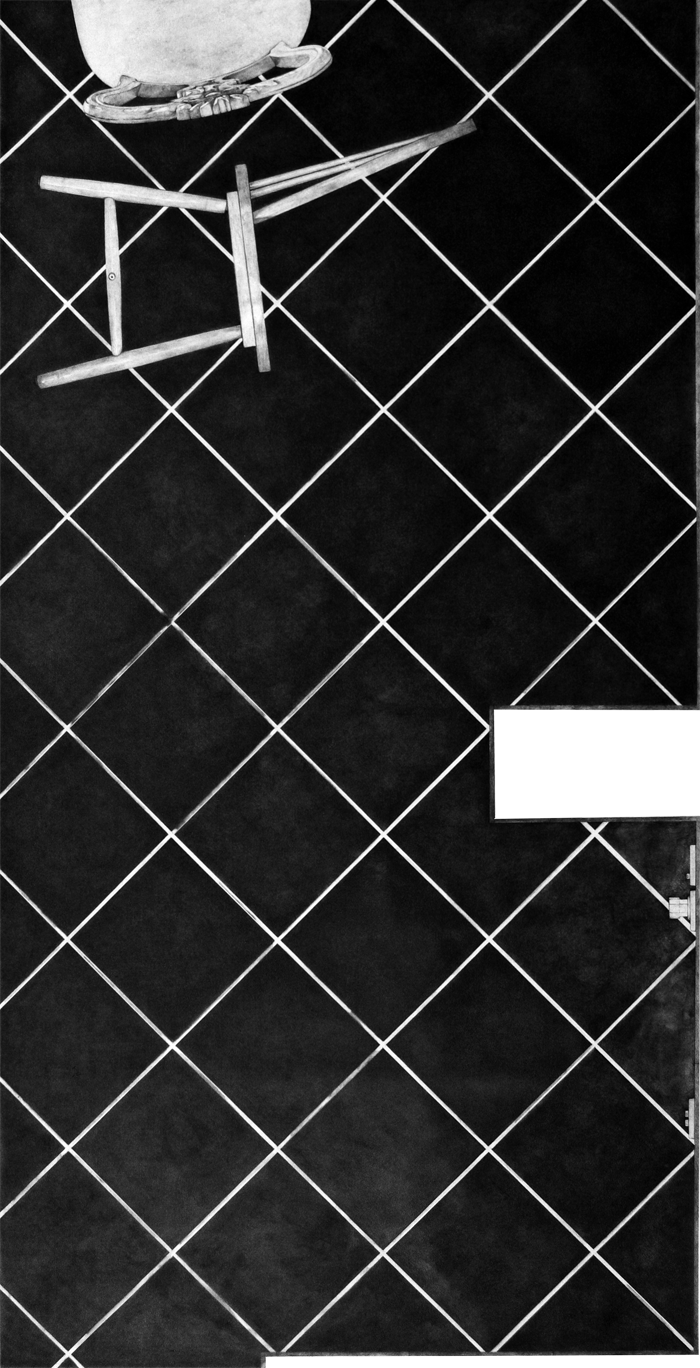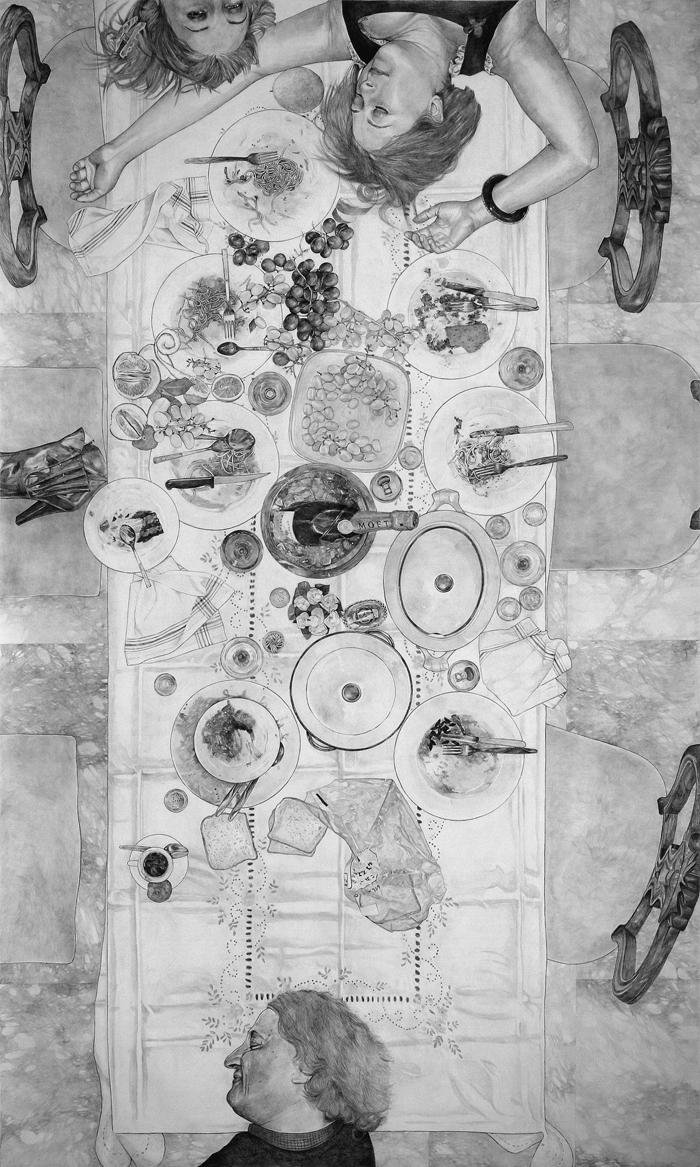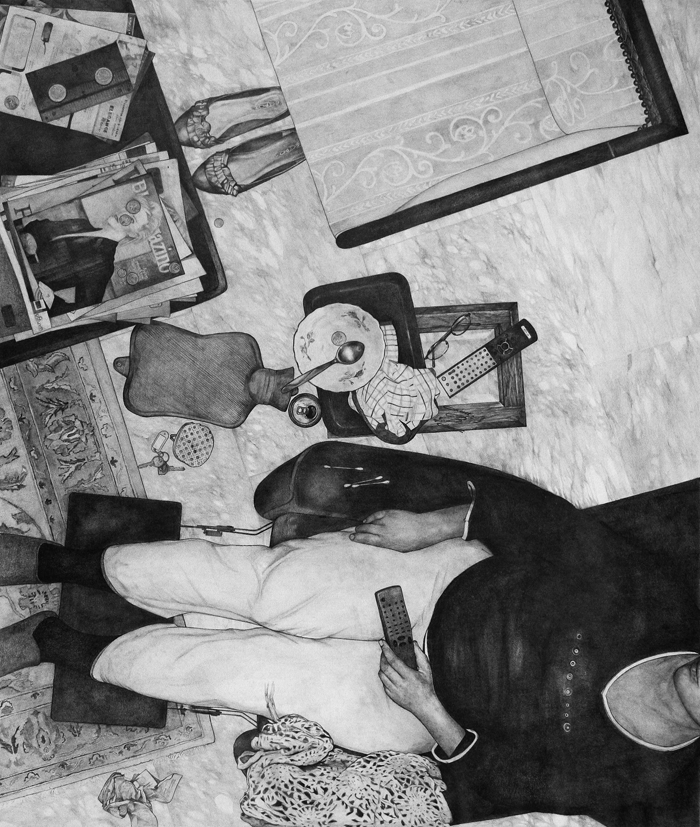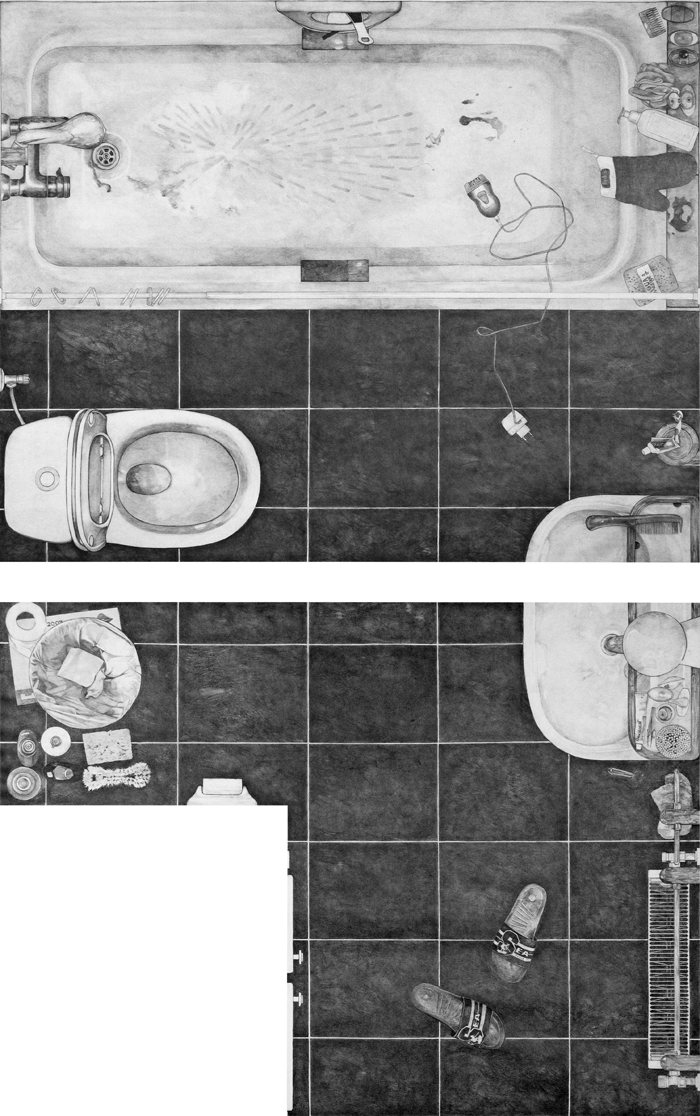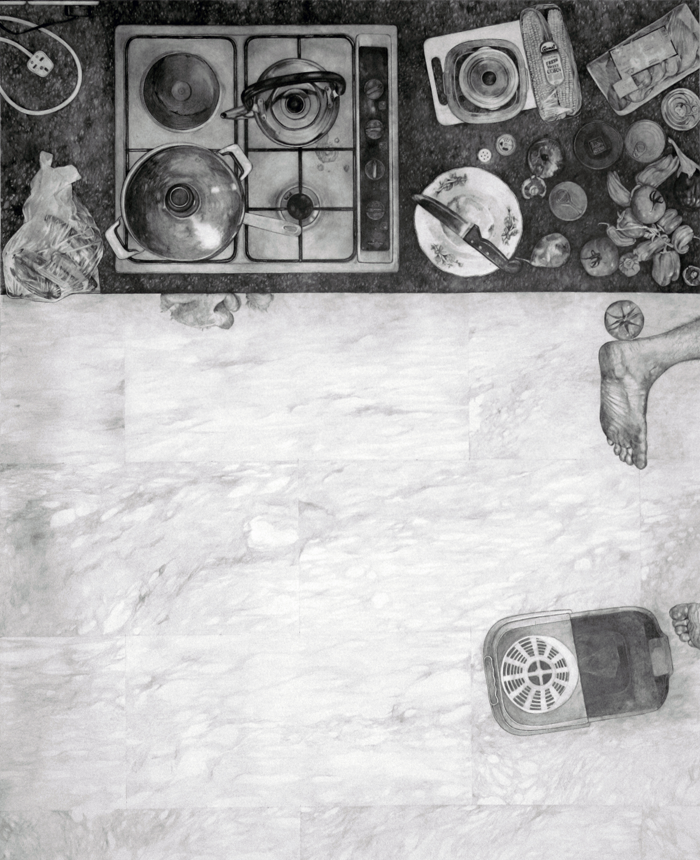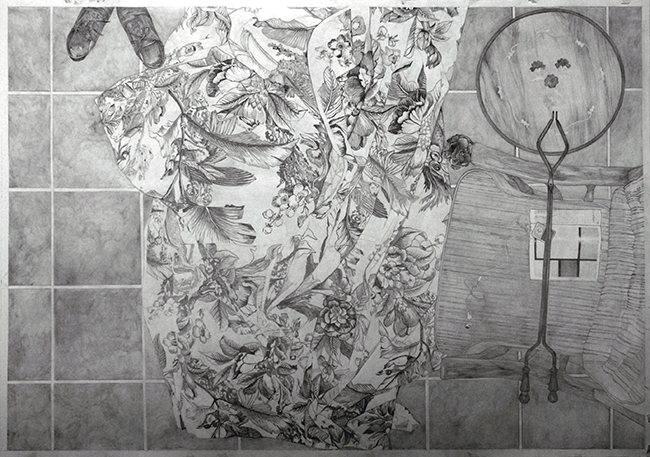The significance of Elina Ioannou’s work does not rely on the fact that she has mastered the art of drawing. Her laborious technical skill and draughtsmanship as well as her meticulous persistence on precise mapping triggers significant memories such as the scientific drawing methods of Albrecht Dürer.
Furthermore it evokes memories of the baroque pursuits of the 17th century, the craftsmen artists, the chiaroscuro imprints of monumental facades, even more it evokes sophisticated interiors and especially the imposing and absolutely utterly theatrical staircases of complex baroque grand mansions.
Observing Elina’s black and white drawings perched on the white-lit gallery walls, the sounds of Henry Purcell’s “Te Deum and Jubilate” the ode to St. Cecilia echoed in my ears. Naturally, the images that come to mind are from Peter Greenaway`s 1982 film The Draughtsman’s Contract: A baroque film noir, laden with erotic implications, which centers around the main character, the apple of discord, a “master draughtsman”. In the initial uncut version Greenaway depicts anachronisms such as a cordless phone and his own paintings in the style of Roy Lichtenstein. I imagine the artist seated long and expended hours in front of her glass grid drafting "snootily" with her polyhedral bird’s eye view creating contemporary images of mystery and love devoid of human presence, laden with seductive references and visual anachronisms. She herself relates the elaborate faux marbre of the residence’s staircase to the explosive pursuits of Jackson Pollock, while the gros plans of the floor with the tangled cables is strongly reminiscent of Mondrian’s compositions in red, blue and yellow. An open art magazine thrown onto an armchair in another drawing only confirms the latter.
Elina Ioannou’s domestic mappings constitute simulacras, impressions of reality which precede their very own existence1.
The initial “crowding” and “cacophony” of the first drawings gradually transforms itself into a placidly detached observation of the visual field with alternating focal points. These "post-Pompeian" icons appear like frozen images and symbols of the post-industrial era, fossils of a non-existent reality. The labyrinthian and complex vocabulary and the seemingly simple but actually complicated relations and combination of the represented objects, refer to a visual deconstruction a la Derrida, a «différance2», a game of absence - presence which is trying to interpret or even avoid metaphysical pursuits.
The used tube of a toothpaste, the shaver thrown in the dirty bath tub, the tangled cable of a circular multi-plug, the Miele vacuum cleaner, a copy of Georges Perec3 (Le Choses perhaps), and the plastic fiber bathing glove could be a black and white, post-Byzantine vanitas, a still life of a living environment, a modern version of Ecclesiastes in futility4, a tight and perhaps fatal embrace a la Klimt, free however from any trace of gold leaf5.
The parallel universes on Elina`s Ioannou papers, devoid of any obvious perspective and ombres portées6, could be situated in that certain transitional space that separates the real from the apparent. In the “Republic” and more specifically in the "Allegory of the Cave”, Plato ties to explain the theory of his ideas through the notion shadows. The prisoners in the cave perceive shadows to be the only substantial reality. Those whom upon exiting the cave get used to the sunlight and see the Agathon, then realize that what the shadows they witnessed were nothing but imitations of reality7.
The objects in the architectural, psychografical ground plans of Ioannou could actually constitute the very shadows of their own reality.
They are confined in miniscule, infra mince according to Duchamp space which constitutes the intersection of two dimensions: an upper and a lower one which fulfill a dual purpose8. In the lower dimension they are projections of un upper reality and in their upper dimension they constitute projections of an higher hipostasis9. They are the large glass that diffracts light above and below and vice versa10. The objective of the process: the ascent toward the light, the perception of the Agathon according to Plato, the reconciliation and, ultimately the immortality of the soul.
Dr. Yiannis Toumazis
1 Baudrillard, Jean, Simulacres et simulation, Paris, Galilée, 1985
2 Derrida, Jacques, “Cogito and the History of Madness” in Writing and Difference, translation A. Bass. London & New York, Routledge, 1978, p. 75
3 Perec, Georges, Les Choses: Une histoire des années soixante, Paris, René Juillard, 1965
4 Vanity futility, [...] everything vanity. Ecclesiastes, Chapter I
5 Reference to Gustav Klimt`s, The Kiss, 1907-1908
6 Οmbres portées = cast shadows
7 Plato, Republic, Introduction, translation, comments, Ι.Ν. Griparis, Preface E. Papanoutsos. Ι–ΙΙ., AtHens, Zacharopoulos
8 Duchamp, Marcel, Notes, Paul Matisse (éd.), Paris, [Centre National d’Art et de Culture Georges Pompidou, 1980], Flammarion, 1999, pp. 19-36
9 Toumazis Yiannis, Marcel Duchamp, Artiste Androgyne, doctoral thesis, Amiens, Université de Picardie Jules Verne, 2009
10 Reference to Marcel Duchamp`s, La Mariée mise à nu par ses célibataires, même - Le Grand Verre (1915-1923)
39.2m² AND I HAVE NO REASON TO LIE
Η σημασία των έργων της Ελίνας Ιωάννου δεν έγκειται μόνο στο γεγονός ότι η ίδια είναι μια άριστη κάτοχος της τέχνης του σχεδίου. Η αριστοτεχνική τεχνική και η επίπονη επιμονή στη λεπτομερή αποτύπωση ενεργοποιεί σημαντικές μνήμες, όπως για παράδειγμα τις επιστημονικές μεθόδους σχεδιασμού του Albrecht Dürer.
Ακόμη περισσότερο φέρνει στο νου τις μπαρόκ αναζητήσεις του 17ου αιώνα, τους καλλιτέχνες τεχνίτες, τις chiaroscuro αποτυπώσεις των μνημειακών προσόψεων, αλλά και των ακόμη πιο εξεζητημένων εσωτερικών, με έμφαση στις επιβλητικές και απόλυτα θεατρικές σκάλες των πολύπλοκων μπαρόκ επαύλεων.
Βλέποντας τα ασπρόμαυρα σχέδια της Ελίνας να στηρίζονται στους λευκά φωτισμένους τοίχους της γκαλερί, αντήχησαν στα αυτιά μου οι ήχοι του Ηenry Purcell, το Te Deum and Jubilate, η ωδή στην Αγία Σεσίλια. Και φυσικά οι εικόνες του Peter Greenaway από το φιλμ The Draughtsman’ s Contract του 1982 , αυτού του μπαρόκ film noir με ερωτικές προεκτάσεις, με επίκεντρο και μήλο της έριδας ένα «μάστορα του σχεδίου». Στην αρχική αμοντάριστη βερσιόν της ταινίας ο Greenaway είχε χρησιμοποιήσει αναχρονισμούς όπως ένα ασύρματο τηλέφωνο καθώς και δικούς του πίνακες σε απομίμηση του ύφους του Roy Lichtenstein. Φαντάζομαι κι εγώ την καλλιτέχνη να κάθεται για ώρες μπροστά στον γυάλινο κάνναβο της και να ιχνογραφεί «αφ’ υψηλού» με την πολύεδρη οπτική ενός πουλιού, δημιουργώντας σύγχρονες εικόνες μυστηρίου και έρωτα, στην ανθρώπινη απουσία, γεμάτες ελκυστικές αναφορές και εικαστικούς αναχρονισμούς. Η ίδια συνδέει το περίτεχνο faux marbre της κλίμακος της οικίας με τις εκρηκτικές αναζητήσεις του Jackson Pollock, ενώ τα gros plans στο πάτωμα με τα μπλεγμένα καλώδια θυμίζουν έντονα τις συνθέσεις σε κόκκινο, μπλε και κίτρινο του Μόντριαν. Ένα ανοιχτό και ριγμένο σε πολυθρόνα περιοδικό τέχνης σε ένα άλλο σχέδιο, επιβεβαιώνει του λόγου το αληθές.
Οι οικιακές χαρτογραφήσεις της Ελίνας Ιωάννου αποτελούν και αυτές simulacra, αποτυπώματα της πραγματικότητας που προηγούνται της ίδιας της ύπαρξης τους1.
Η αρχική «πολυκοσμία» και «κακοφωνία» των πρώτων σχεδίων, μεταβάλλεται σταδιακά σε μια απόμακρη και ήρεμη παρατήρηση του οπτικού πεδίου με μεταβαλλόμενα και αλληλοεπικαλυπτόμενα σημεία εστίασης. Αυτές οι «μετά-πομπηϊανές» εικόνες φαντάζουν ως παγωμένα πλάνα συμβόλων και σημείων της μεταβιομηχανικής εποχής, απολιθώματα μιας μη υπαρκτής, πραγματικότητας.
Το δαιδαλώδες και πολυσύνθετο λεξιλόγιο και οι φαινομενικά απλές, αλλά ουσιαστικά πολύπλοκες σχέσεις και αλληλοσυναρτήσεις των παριστώμενων αντικειμένων, παραπέμπουν σε μια εικαστική αλά Derrida αποδόμηση και «différance2», ένα παιγνίδι απουσίας – παρουσίας που προσπαθεί να ερμηνεύσει ή ακόμα να αποφύγει τις μεταφυσικές αναζητήσεις.
Το χρησιμοποιημένο σωληνάριο της οδοντόπαστας, η πεταγμένη στη λερωμένη μπανιέρα ξυριστική μηχανή, το μπλεγμένο καλώδιο ενός κυκλικού πολύπριζου, η ηλεκτρική σκούπα Miele, ένα αντίτυπο (ίσως των Choses) του Georges Perec3, και το τρίχινο, πλαστικό γάντι λουσίματος συνθέτουν μια ασπρόμαυρη, μεταβυζαντινή vanitas, μια νεκρή φύση ζωντανού περιβάλλοντος, μια σύγχρονη εκδοχή της κατά Εκκλησιαστήν ματαιότητος4, ενός σφιχτού και ίσως θανάσιμου εναγκαλισμού κατά Klimt, απαλλαγμένου όμως από κάθε ίχνος φύλλου χρυσού5
Τα παράλληλα σύμπαντα στο χαρτί της Ελίνας Ιωάννου, από τα οποία απουσιάζει η συνήθης προοπτική και οι ombres portées6, είναι σαν να βρίσκονται στο μεταβατικό εκείνο χώρο που διαχωρίζει το φαινομενικό από το πραγματικό. Στην Πολιτεία και συγκεκριμένα στην «Αλληγορία του Σπηλαίου», ο Πλάτωνας μέσω των σκιών προσπαθεί να εξηγήσει την θεωρία των ιδεών του. Οι φυλακισμένοι στο σπήλαιο εκλαμβάνουν τις σκιές ως την μόνη υπαρκτή πραγματικότητα. Όσοι βγαίνοντας από το σπήλαιο συνηθίσουν το φως του ήλιου και αντιληφθούν το Αγαθόν, τότε συνειδητοποιούν πως ότι έβλεπαν ήταν αντίγραφα της πραγματικότητας7. Τα αντικείμενα στις αρχιτεκτονικές, ψυχογραφικές κατόψεις της Ιωάννου, αποτελούν ίσως και τα ίδια, τις σκιές της δικής τους πραγματικότητας.
Βρίσκονται εγκλωβισμένα σε ένα απειροελάχιστο, infra mince κατά Marcel Duchamp χώρο, ο οποίος αποτελεί την τομή δύο διαστάσεων: μίας ανώτερης και μίας κατώτερης και έχουν διττή υπόσταση8. Ιδωμένα στην κατώτερη διάσταση αποτελούν προβολές της ανώτερης πραγματικότητας ενώ στην ανώτερη διάσταση αποτελούν και πάλι προβολές μιας ακόμη πιο ψηλής υπόστασης9. Είναι τα μεγάλα γυαλιά που διαθλούν το φως από πάνω προς τα κάτω και αντίστροφα10. Το ζητούμενο της διαδικασίας: η άνοδος προς το φως, η κατά Πλάτωνα αντίληψη του Αγαθού, η συμφιλίωση, και εν τέλει και αμετάκλητα, η αθανασία της ψυχής.
Δρ. Γιάννης Τουμαζής
1 Baudrillard, Jean, Simulacres et simulation, Paris, Galilée, 1985
2 Derrida, Jacques, “Cogito and the History of Madness” in Writing and Difference, μετάφρ. A. Bass. London & New York, Routledge, 1978, σ. 75
3 Perec, Georges, Les Choses: Une histoire des années soixante, Paris, René Juillard, 1965
4 «Ματαιότης ματαιοτήτων, [...] τα πάντα ματαιότης». Εκκλησιαστής, Κεφάλαιον Α’.
5 Αναφορά στο έργο του Gustav Klimt, The Kiss, 1907-1908
6 Οmbres portées = εριμμένες σκιές
7 Πλάτων, Πολιτεία, Εισαγωγή, μετάφραση, σχόλια, Ι.Ν. Γρυπάρης, Πρόλογος Ε. Παπανούτσος. Ι–ΙΙ., Αθήνα, Ζαχαρόπουλος
8 Duchamp, Marcel, Notes, Paul Matisse (éd.), Paris, [Centre National d’Art et de Culture Georges Pompidou, 1980], Flammarion, 1999, pp. 19-36
9 Βλέπε Toumazis Yiannis, Marcel Duchamp, Artiste Androgyne, Διδακτορική διατριβή, Amiens, Université de Picardie Jules Verne, 2009
10 Αναφορά στο έργο του Marcel Duchamp, Το Μεγάλο Γυαλί, ή La Mariée mise à nu par ses célibataires, même - Le Grand Verre (1915-1923)
